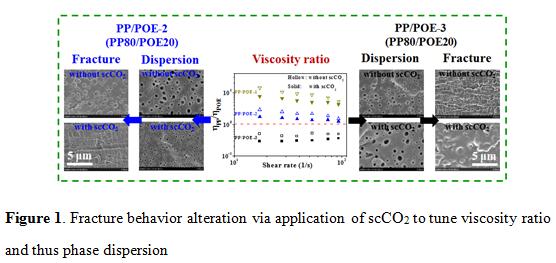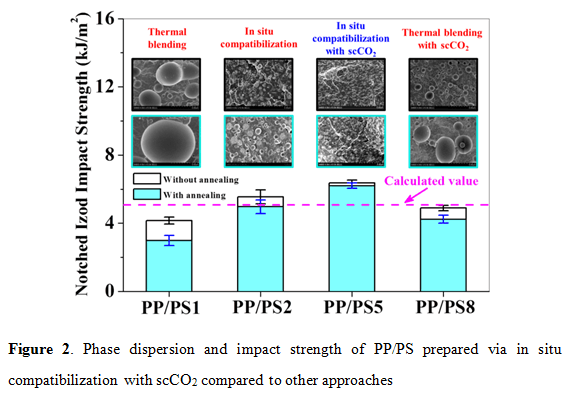Driven by sustainable development, the polymer processing means that are of low efficiency and high consumption have been gradually phased out, while new, advanced approaches are greatly demanded for high-efficiency fabrication and environmental friendliness purposes. Supercritical fluids show liquid-like density, gas-like viscosity and high diffusion rates, which allow them to be widely used in extraction, drying, particle formation and polymer foaming, etc. Among the supercritical fluids, supercritical carbon dioxide (scCO2) has been the one mostly applied due to its non-toxicity, chemical inertness, low cost as well as mild supercritical condition.
Recently, the advanced polymer processing group from Ningbo Institute of Materials Technology and Engineering, Chinese Academy of Sciences (NIMTE, CAS) has made great efforts in applying innovative strategies to explore advanced approaches for polymer processing via utilizing a tandem continuous extrusion system with scCO2 as the processing medium. The recent progresses would provide advances for developing new approaches and establishing new methodologies for polymer processing.
1. Altering the fracture behavior of polymer blends via tuning phase dispersion with scCO2
Brittle-tough transition (BTT) has been an interesting subject from both fundamental and industrial perspectives. Traditionally, changing the variables such as the content of rubbers or thermoplastic elastomers as well as the crosshead speed and the environmental temperature is the conventional means to tune BTT. While the variables above were kept constant, the fracture mode of polypropylene/polyolefin elastomer blends was altered by controlling the phase dispersion via adjusting the viscosity ratio of PP and POE with scCO2 as the processing medium (Figure 1). The application of scCO2 during polymer processing has added one more approach that can be utilized not only to tune the fracture mode transition from brittle to tough, but also vice versa. Therefore, this study opens a new horizon on how to control BTT from the aspect of polymer processing with scCO2. (Patent: 201610117411.8; RSC Adv., 2016, 6: 106347-106354)

2. Enhancing the flame retardancy via improving the dispersion of flame retardants with scCO2
Incorporating synergistic agents is the common means to improve the efficiency of flame retardants and the flame retardant performance of the corresponding composites. Without incorporating the synergistic agents, the efficiency of flame retardants was highly improved via using scCO2 as the processing medium to improve the dispersion of intumescent flame retardants (IFR) in PP matrix. A low loading of 23 wt% IFR allowed the PP composites to pass UL-94 V-0 rating, which usually requires no less than 30 wt% for the conventional approaches. This application combines the characteristics of pilot-scale production of continuous extrusion and environmental friendliness, easy removal and low cost of scCO2. Therefore, it has demonstrated potential to establish a new approach to improve the flame retardancy of PP/IFR composites, and this approach is highly expected to be applied to many other flame retardant systems. (Patent: 201610252554.X, 201610254837.8; RSC Adv., 2016, 6: 112184-112192)
3. Improving in situ compatibilization via promoting the yield of interfacial compatibilizers with scCO2
Reactive extrusion is usually applied to directly generate compatibilizers in the interfacial regions to render immiscible polymer blends improved interfacial adhesion and consequently better phase morphology and physical properties. With scCO2 as the medium of the reactive extrusion, the yield of the interfacial modifiers was promoted, and thus further improved the in situ compatibilization (Figure. 2). Compared to the other approaches (thermal blending without scCO2, thermal blending with scCO2 and in situ compatibilization without scCO2), in situ compatibilization with scCO2 has proved to be a more effective approach in improving phase dispersion and enhancing mechanical properties. (Patent: 201510560530.6; J. Supercrit. Fluids, 2016, 118: 203-209)

Dr. Yongyan Pang (Associate professor, yongyan.pang@nimte.ac.cn)
Dr. Wenge Zheng (Professor, wgzheng@nimte.ac.cn)
All images by ![]()

